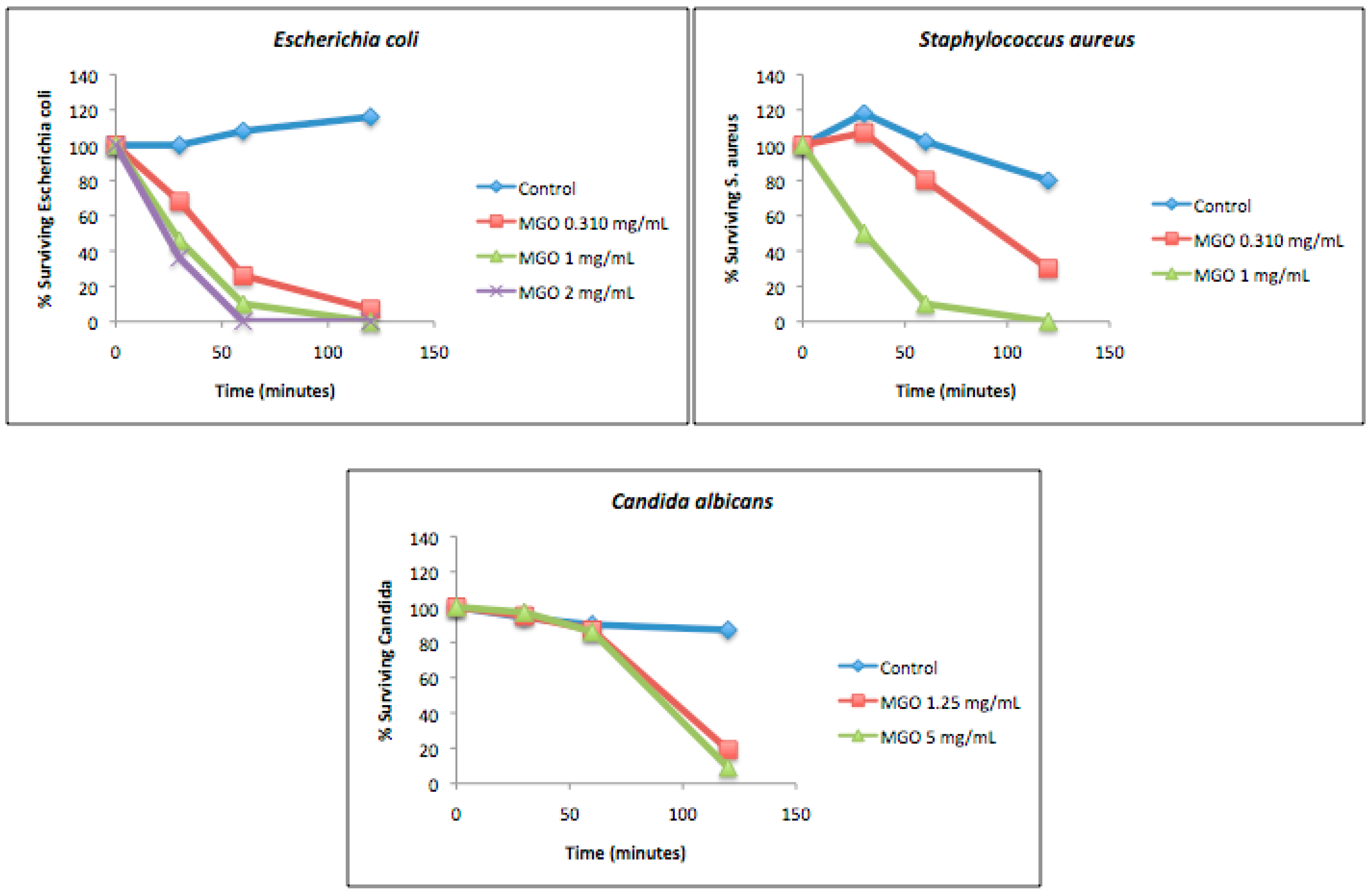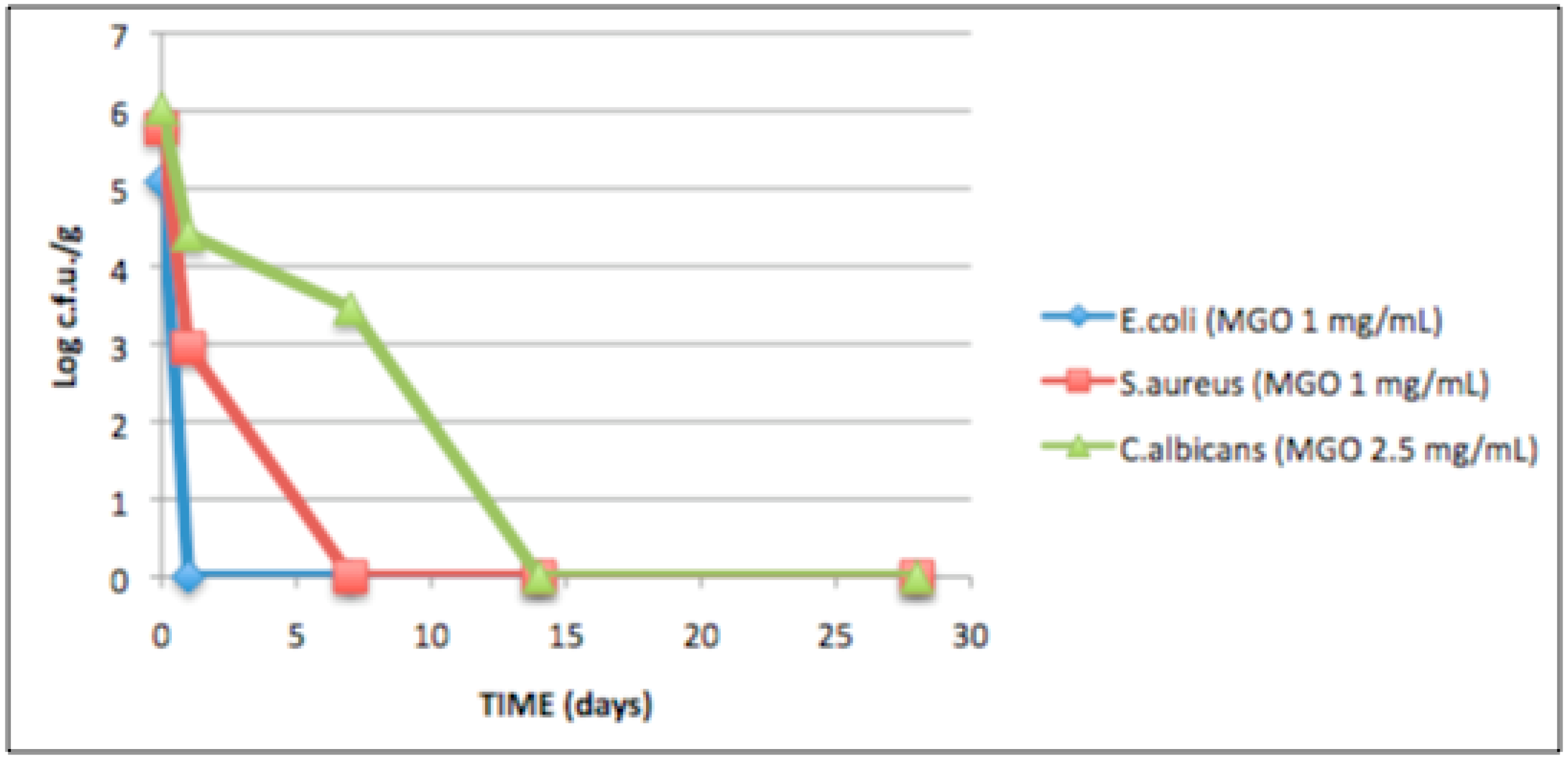Methylglyoxal, the Major Antibacterial Factor in Manuka Honey: An Alternative to Preserve Natural Cosmetics?
Abstract
:1. Introduction
2. Materials and Methods
2.1. Materials
2.2. Antibacterial Activity of MGO
2.3. Antifungal Activity of MGO
2.4. Killing Time Test
2.5. Challenge Test
2.6. Enhancement by Chitosan
3. Results
3.1. Antimicrobial Activity of MGO
3.2. Killing Time Test
3.3. Challenge Test
3.4. Interaction of MGO with Chitosan
4. Discussion
Author Contributions
Funding
Conflicts of Interest
References
- Halla, N.; Fernandes, I.P.; Heleno, S.A.; Costa, P.; Boucherit-Otmani, Z.; Boucherit, K.; Rodrigues, A.E.; Ferreira, I.C.F.R.; Barreiro, M.F. Cosmetic preservation: A review on present strategies. Molecules 2018, 23, 1571. [Google Scholar] [CrossRef] [PubMed]
- European Commission (EC). Regulation (EC) No 1223/2009 of the European Parliament and of the Council of 30 November 2009 on cosmetic products. Off. J. Eur. Union 2009, 27, 59–209. [Google Scholar]
- Yim, E.; Baquerizo Nole, K.L.; Tosti, A. Contact dermatitis caused by preservatives. Dermatitis 2014, 25, 215–231. [Google Scholar] [CrossRef] [PubMed]
- Nohynek, G.J.; Borgert, C.J.; Dietrich, D.; Rozman, K.K. Endocrine disruption: Fact or urban legend? Toxicol. Lett. 2013, 223, 295–305. [Google Scholar] [CrossRef] [PubMed]
- Golden, R.; Gandy, J.; Vollmer, G. A review of the endocrine activity of parabens and implication for potential risks to human health. Crit. Rev. Toxicol. 2005, 35, 435–458. [Google Scholar] [CrossRef]
- Darbre, P.D. Environmental oestrogens, cosmetics and breast cancer. Best Pract. Res. Clin. Endocrinol. Metab. 2006, 20, 121–143. [Google Scholar] [CrossRef]
- Witorsch, R.J.; Thomas, J.A. Personal care products and endocrine disruption: A critical review of the literature. Crit. Rev. Toxicol. 2010, 40 (Suppl. 3), 1–30. [Google Scholar] [CrossRef]
- Maccioni, A.M.; Anchisi, C.; Sanna, A.; Sardu, C.; Dessì, S. Preservative systems containing essential oils in cosmetic products. Int. J. Cosmet. Sci. 2002, 24, 53–59. [Google Scholar] [CrossRef]
- Muyima, N.Y.O.; Zulu, G.; Benghu, T.; Popplewell, D. The potential application of some novel essential oils as natural cosmetic preservatives in an aqueous cream formulation. Flavour Fragr. J. 2002, 17, 258–266. [Google Scholar] [CrossRef]
- Ibarra, F.; Johnson, G.H. Natural preservatives from concepts in nature. Cosmet. Toiletries 2008, 123, 81–90. [Google Scholar]
- Herman, A.; Herman, A.P.; Domagalska, B.W.; Mlynarczyk, A. Essential oils and herbal extracts as antimicrobial agents in cosmetic emulsions. Indian J. Microbiol. 2013, 53, 232–237. [Google Scholar] [CrossRef] [PubMed]
- Juliano, C.; Gavini, E.; Giunchedi, P.; Magrini, G.A. Evaluation of Manuka honey as an adjuvant antimicrobial preservative in a O/W emulsion. J. Appl. Cosmet. 2016, 34, 87–98. [Google Scholar]
- George, N.M.; Cutting, K.F. Antibacterial honey (MedihoneyTM): In-vitro activity against clinical isolates of MRSA, VRE and other multiresistant Gram-negative organisms including Pseudomonas aeruginosa. Wounds 2007, 19, 231–236. [Google Scholar] [PubMed]
- Lin, S.M.; Molan, P.C.; Cursons, R.T. The in vitro susceptibility of Campylobacter spp. to the antibacterial effect of manuka honey. Eur. J. Clin. Microbiol. Infect. Dis. 2009, 28, 339–344. [Google Scholar] [CrossRef] [PubMed]
- Majtan, J.; Bohova, J.; Horniakova, M.; Klaudiny, J.; Majtan, V. Anti-biofilm effects of honey against wound pathogens Proteus mirabilis and Enterobacter cloacae. Phytother. Res. 2014, 28, 69–75. [Google Scholar] [CrossRef] [PubMed]
- Adams, C.J.; Boult, C.H.; Deadman, B.J.; Farr, J.M.; Grainger, M.N.; Manley-Harris, M.; Snow, M.J. Isolation by HPLC and characterisation of the bioactive fraction of New Zealand manuka (Leptospermum scoparium) honey. Carbohydr. Res. 2008, 343, 651–659. [Google Scholar] [CrossRef] [PubMed]
- Mavric, E.; Wittmann, S.; Barth, G.; Henle, T. Identification and quantification of methylglyoxal as the dominant antibacterial constituent of Manuka (Leptospermum scoparium) honeys from New Zealand. Mol. Nutr. Food Res. 2008, 52, 483–489. [Google Scholar] [CrossRef] [PubMed]
- Kwakman, P.H.S.; te Velde, A.A.; de Boer, L.; Vandenbroucke-Graus, C.M.J.E.; Zaat, S.A.J. Two major medicinal honeys have different mechanisms of bactericidal activity. PLoS ONE 2011, 6, e17709. [Google Scholar] [CrossRef]
- No, H.K.; Park, N.Y.; Lee, S.H.; Meyers, S. Antibacterial activity of chitosans and chitosan oligomers with different molecular weight. Int. J. Food Microbiol. 2002, 74, 65–72. [Google Scholar] [CrossRef]
- Thrupp, L. Susceptibility testing of antibiotics in liquid media. In Antibiotics in Laboratory Medicine, 2nd ed.; Lorian, V., Ed.; Williams and Wilkins: Baltimore, MD, USA, 1986; pp. 93–158. ISBN 0-683-05167-9. [Google Scholar]
- McGinnis, M.R.; Rinaldi, M.G. Antifungal drugs: Mechanisms of action, drug resistance, susceptibility testing and assays of activity in biological fluids. In Antibiotics in Laboratory Medicine, 2nd ed.; Lorian, V., Ed.; Williams and Wilkins: Baltimore, MD, USA, 1986; pp. 223–281. ISBN 0-683-05167-9. [Google Scholar]
- Juliano, C.; Demurtas, C.; Piu, L. In vitro study on the anticandidal activity of Melaleuca alternifolia (tea tree) essential oil combined with chitosan. Flavour Fragr. J. 2008, 23, 227–231. [Google Scholar] [CrossRef]
- European Pharmacopoeia Commission. European Pharmacopoeia, 7th ed.; European Directorate for the Quality of Medicines & Healthcare (EDQM): Strasbourg, France, 2011. [Google Scholar]
- Kalapos, M.P. Methylglyoxal in living organisms. Chemistry, biochemistry, toxicology and biological implications. Toxicol. Lett. 1999, 110, 145–175. [Google Scholar] [CrossRef]
- Committee on Toxicity of Chemical in Food, Consumer Products and the Environment. Statement on Methylglyoxal. 2009. Available online: https://cot.food.gov.uk/committee/committee-on-toxicity/cotstatements/cotstatementsyrs/cotstatements2009/cot200904 (accessed on 23 September 2018).
- IARC. Coffee, tea, mate, methylxanthines and methylglyoxal. IARC Working Group on the evaluation of carcinogenic risks to human. IARC Monogr. Eval. Carcinog. Risks Hum. 1991, 51, 1–513. [Google Scholar]
- Aranaz, I.; Acosta, N.; Civera, C.; Elorza, B.; Mingo, J.; Castro, C.; de Los Llanos Gandía, M.; Caballero, A.H. Cosmetics and cosmeceutical applications of chitin, chitosan and their derivatives. Polymers 2018, 10, 213. [Google Scholar] [CrossRef]


| Strain | M.I.C. | M.B.C./M.F.C. |
|---|---|---|
| Escherichia coli ATCC 8739 | 0.220 mg/mL (0.022%) | 0.310 mg/mL (0.031%) |
| Pseudomonas aeruginosa ATCC 9027 | 0.310 mg/mL (0.031%) | 0.310 mg/mL (0.031%) |
| Staphylococcus aureus ATCC 6538 | 0.150 mg/mL (0.015%) | 0.310 mg/mL (0.031%) |
| Streptococcus mutans ATCC 35668 | 0.150 mg/mL (0.015%) | 0.310 mg/mL (0.031%) |
| Candida albicans ATCC 10231 | 0.630 mg/mL (0.063%) | 1.25 mg/mL (0.125%) |
| Candida spp. from rectal swab (1) | 1.25 mg/mL (0.125%) | 5 mg/mL (0.5%) |
| Candida spp. from pharyngeal swab (2) | 1.25 mg/mL (0.125%) | 5 mg/mL (0.5%) |
| Candida spp. from vaginal swab (3) | 1.25 mg/mL (0.125%) | 5 mg/mL (0.5%) |
| Rhodotorula mucilaginosa ATCC 66034 | 1.25 mg/mL (0.125%) | 3.75 mg/mL (0.375%) |
| Aspergillus brasiliensis ATCC 16404 | 10 mg/mL (1%) | 10 mg/mL (1%) |
| Geotrichum candidum ATCC 34614 | 7.5 mg/mL (0.75%) | 7.5 mg/mL (0.75%) |
| Escherichia coli | Pseudomonas aeruginosa | Candida spp. Strain 1 | |
|---|---|---|---|
| M.I.C. Chitosan | 0.063 mg/mL | 0.25 mg/mL | 1 mg/mL |
| M.B.C. Chitosan | 0.063 mg/mL | 0.5 mg/mL | 1 mg/mL |
| M.I.C. MGO | 0.220 mg/mL | 0.310 mg/mL | 1.25 mg/mL |
| M.B.C/M.F.C. MGO | 0.310 mg/mL | 0.310 mg/mL | 5 mg/mL |
| M.I.C. MGO + 1/2 M.I.C. Chitosan | 0.015 mg/mL | 0.15 mg/mL | 1.25 mg/mL |
| M.B.C. MGO + 1/2 M.I.C. Chitosan | 0.031 mg/mL | 0.15 mg/mL | 1.25 mg/mL |
| M.I.C. MGO + 1/4 M.I.C. Chitosan | 0.07 mg/mL | 0.310 mg/mL | 2.5 mg/mL |
| M.B.C. MGO + 1/4 M.I.C. Chitosan | 0.07 mg/mL | 0.310 mg/mL | 2.5 mg/mL |
© 2018 by the authors. Licensee MDPI, Basel, Switzerland. This article is an open access article distributed under the terms and conditions of the Creative Commons Attribution (CC BY) license (http://creativecommons.org/licenses/by/4.0/).
Share and Cite
Juliano, C.; Magrini, G.A. Methylglyoxal, the Major Antibacterial Factor in Manuka Honey: An Alternative to Preserve Natural Cosmetics? Cosmetics 2019, 6, 1. https://doi.org/10.3390/cosmetics6010001
Juliano C, Magrini GA. Methylglyoxal, the Major Antibacterial Factor in Manuka Honey: An Alternative to Preserve Natural Cosmetics? Cosmetics. 2019; 6(1):1. https://doi.org/10.3390/cosmetics6010001
Chicago/Turabian StyleJuliano, Claudia, and Giovanni Antonio Magrini. 2019. "Methylglyoxal, the Major Antibacterial Factor in Manuka Honey: An Alternative to Preserve Natural Cosmetics?" Cosmetics 6, no. 1: 1. https://doi.org/10.3390/cosmetics6010001
APA StyleJuliano, C., & Magrini, G. A. (2019). Methylglyoxal, the Major Antibacterial Factor in Manuka Honey: An Alternative to Preserve Natural Cosmetics? Cosmetics, 6(1), 1. https://doi.org/10.3390/cosmetics6010001





